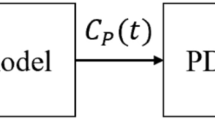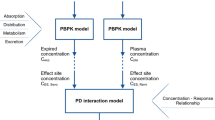Abstract
In this article we review how population pharmacokinetic/pharmacodynamic (PD) modeling has evolved in the specialty of anesthesiology, how anesthesiology benefited from the mixed-effects approach, and which features of modeling need careful attention. Key articles from the anesthesiology literature are selected to discuss the modeling of typical anesthesiological PD end points, such as level of consciousness and analgesia, interactions between hypnotics and analgesics, estimation with poor and sometimes rich data sets from populations of various sizes, covariate detection, covariances between random effects, and Bayesian forecasting.
Similar content being viewed by others
References
NONMEM Project Group. NONMEM User's Guide. San Francisco, CA: University of California; 1999.
Minto CF, Schnider TW. Expanding clinical applications of population pharmacodynamic modeling.Br J Clin Pharmacol. 1998;46:321–333.
Wright PMC. Population based pharmacokinetic analysis: why do we need it; what is it; and what has it told us about anaesthetics.Br J Anaesth. 1998;80:488–501.
Whiting B, Kelman AW, Grevel J. Population pharmacokinetics. Theory and clinical application.Clin Pharmacokinet. 1986;11:387–401.
Maitre PO, Vozeh S, Heykants J, Thomson DA, Stanski DR. Population pharmacokinetics of alfentanil: the average dose-plasma concentration relationship and interindividual variability in patients.Anesthesiology. 1987;66:3–12.
Grevel J, Whiting B. The relevance of pharmacokinetics to optimal intravenous anesthesia.Anesthesiology. 1987;66:1–2.
Kataria BK, Ved SA, Nicodemus HF, et al. The pharmacokinetics of propofol in children using three different data analysis approaches.Anesthesiology. 1994;80:104–122.
Fisher DM. Propofol in pediatrics. Lessons in pharmacokinetic modeling.Anesthesiology. 1994;80:2–5.
Schüttler J, Ihmsen H. Population pharmacokinetics of propofol: a multicenter study.Anesthesiology. 2000;92:727–738.
Schnider TW, Minto CF, Gambus PL, et al. The influence of method of administration and covariates on the pharmacokinetics of propofol in adult volunteers.Anesthesiology. 1998;88:1170–1182.
Hull CJ. How far can we go with compartmental models?Anesthesiology. 1990;72:399–402.
Boer F. Drug handling by the lungs.Br J Anaesth. 2003;91:50–60.
Krejcie TC, Henthorn TK, Shanks CA, Avram MJ. A recirculatory pharmacokinetic model describing the circulatory mixing, tissue distribution and elimination of antipyrine in dogs.J Pharm Exp Ther. 1994;269:609–616.
Kuipers JA, Boer F, Olofsen E, Bovill JG, Burm AGL. Recirculatory pharmacokinetics and pharmacodynamics of rocuronium in patients—the influence of cardiac output.Anesthesiology. 2001;94:47–55.
Sheiner LB, Stanski DR, Vozeh S, Miller RD, Ham J. Simultaneous modeling of pharmacokinetics and pharmacodynamics: application to d-tubocurarine.Clin Pharmacol Ther. 1979;25:358–371.
Stanski DR, Maitre PO. Population pharmacokinetics and pharmacodynamics of thiopental: the effect of age revisited.Anesthesiology. 1990;72:412–422.
Somma J, Donner A, Zomorodi K, et al. Population pharmacodynamics of midazolam administered by target controlled infusion in SICU patients after CABG surgery.Anesthesiology. 1998;89:1430–1443.
Fábregas N, Rapado J, Gambús PL, et al. Modeling of the sedative and airway obstruction effects of propofol in patients with Parkinson disease undergoing stereotactic surgery.Anesthesiology. 2002;97:1378–1386.
Knibbe CAJ, Zuideveld KP, DeJongh J, Kuks PFM, Aarts LPHJ, Danhof M. Population pharmacokinetic and pharmacodynamic modeling of propofol for long-term sedation in critically ill patients: a comparison between propofol 6% and propofol 1%.Clin Pharmacol Ther. 2002;72:670–684.
Doufas AG, Bakhshandeh M, Bjorksten AR, Shafer SL, Sessler DI. Induction speed is not a determinant of propofol pharmacodynamics.Anesthesiology. 2004;101:1112–1121.
Minto CF, Schnider TW, Egan TD, et al. Influence of age and gender on the pharmacokinetics and pharmacodynamics of remifentanil. I. Model development.Anesthesiology. 1997;86:10–23.
Anderson BJ, Holford NHG, Woollard GA, Kanagasundaram S, Mahadevan M. Perioperative pharmacodynamics of acetaminophen analgesia in children.Anesthesiology. 1999;90:411–421.
Rehberg B, Bouillon T, Grünewald M, et al. Comparison of the concentration-dependent effect of sevoflurane on the spinal H-reflex and the EEG in humans.Acta Anaesthesiol Scand. 2004;48:569–576.
Johansen JW, Sebel PS. Development and clinical application of electroencephalographic bispectrum monitoring.Anesthesiology. 2000;93:1336–1344.
Röpcke H, Rehberg B, Koenen-Bergmann M, Bouillon T, Bruhn J, Hoeft A. Surgical stimulation shifts EEG concentration-response relationship of desflurane.Anesthesiology. 2001;94:390–399.
Sarton E, Olofsen E, Romberg R, et al. Sex differences in morphine analgesia: an experimental study in healthy volunteers.Anesthesiology. 2000;93:1245–1254.
Luginbühl M, Schnider TW, Petersen-Felix S, Arendt-Nielsen L, Zbinden AM. Comparison of five experimental pain tests to measure analgesic effects of alfentanil.Anesthesiology. 2001;95:22–29.
Olofsen E, Romberg R, Bijl H, et al. Alfentanil and placebo analgesia: no sex differences detected in models of experimental pain.Anesthesiology. 2005;103:130–139.
Romberg RR, Olofsen E, Bijl H, et al. Polymorphism of μ-opioid receptor gene (OPRM1:c. 118A>G) does not protect against opioid-induced respiratory depression despite reduced analgesic response.Anesthesiology. 2005;102:522–530.
Romberg R, Olofsen E, Sarton E, Teppema L, Dahan A. Pharmacodynamic effect of morphine-6-glucoronide versus morphine on hypoxic and hypercapnic breathing in healthy volunteers.Anesthesiology. 2003;99:788–798.
Bouillon T, Bruhn J, Radu-Radulescu L, Andresen C, Cohane C, Shafer SL. A model of the ventilatory-depressant potency of remifentanil in the non-steady state.Anesthesiology. 2003;99:779–787.
Dahan A, Romberg R, Teppema L, Sarton E, Bijl H, Olofsen E. Simultaneous measurement and integrated analysis of analgesia and respiration after an intravenous morphine infusion.Anesthesiology. 2004;101:1201–1209.
Olofsen E, Sleigh JW, Daham A. The influence of remifentanil on the dynamic relationship between sevoflurane and surrogate anesthetic effect measures derived from the EEG.Anesthesiology. 2002;96:555–564.
Minto CF, Schnider TW, Short TG, Gregg KM, Gentilini A, Shafer SL. Response surface model for anesthetic drug interactions.Anesthesiology. 2000;92:1603–1616.
Bouillon TW, Bruhn J, Radulescu L, et al. Pharmacodynamic interaction between propofol and remifentanil regarding hypnosis, tolerance of laryngoscopy, bispectral index, and electroencephalographic approximate entropy.Anesthesiology. 2004;100:1353–1372.
Dahan A, Nieuwenhuijs D, Olofsen E, Sarton E, Romberg R, Teppema L. Response surface modeling of alfentanil-sevoflurane interaction on cardiorespiratory control and bispectral index.Anesthesiology. 2001;94:982–991.
Nieuwenhuijs DJF, Olofsen E, Romberg RR, et al. Response surface modeling of remifentanil-propofol interaction on cardiorespiratory control and bispectral index.Anesthesiology. 2003;98:312–322.
Maitre PO, Bührer M, Thomson D, Stanski DR. A three-step approach combining Bayesian regression: application to midazolam.J Pharmacokinet Biopharm. 1991;19:377–384.
Mandema JW, Verotta D, Sheiner LB. Building population pharmacokineticpharmacodynamic models.J Pharmacokinet Biopharm. 1992;20:511–528.
Ette El. Stability and performance of a population pharmacokinetic model.J Clin Pharmacol. 1997;37:486–495.
Olofsen E, Dahan A. Response surface modeling of drug interactions: model selection and multimodel inference using the bootstrap. In: Ward DS, Dahan A, Teppema LJSM, eds.Pharmacology and Pathophysiology of the Control of Breathing. New York: Marcel Dekker; 2005.
Bonate PL. The effect of collinearity on parameter estimates in nonlinear mixed effects models.Pharm Res. 1999;16:709–717.
Ribbing J, Jonsson EN. Power, selection bias and predictive performance of the population pharmacokinetic covariate model.J Pharmacokinet Pharmacodyn. 2004;31:109–134.
Wählby U, Jonsson EN, Karlsson MO. assessment of actual significance levels for covariate effects in NONMEN.J Pharmacokinet Pharmacodyn. 2001;28:231–252.
Wallenstein GC, Stangier J, Ludden TM. Analyzing rich data using different methods provided by NONMEM: pharmacokinetics of telmisartan following intravenous infusion to healthy volunteers.Pharm Res. 1999;16:772–776.
Jonsson EN, Karlsson MO. Nonlinearity detection: advantages of nonlinear mixed-effects modeling.AAPS Pharm Sci. 2000;2:E32.
Lindsey JK, Jones B, Jarvis P. Some statistical issues in modelling pharmacokinetic data.Stat Med. 2001;20:2775–2783.
Sheiner LB. The intellectual health of clinical drug evaluation.Clin Pharmacol Ther. 1991;50:4–9.
Burnham KP, Anderson DR. Model Selection and Multimodel Inference, 2nd ed. New York: Springer; 2002.
Akaike H. A new look at the statistical model identification.IEEE Trans Automat Contr. 1974;19:716–723.
Kuipers JA, Boer F, DeRoode A, Olofsen E, Bovill JG, Burm AGL. Modeling population pharmacokinetics of lidocaine: should cardiac output be included as a patient factor?Anesthesiology. 2001;94:566–573.
Minto CF, Schnider TW, Shafer SL. Pharmacokinetics and pharmacodynamics of remifentanil. II. Model application.Anesthesiology. 1997;86:24–33.
Short TG, Ho TY, Minto CF, Schnider TW, Shafer SL. Efficient trial design for eliciting a pharmacokinetic-pharmacodynamic model-based response surface describing the interaction between two intravenous anesthetic drugs.Anesthesiology. 2002;96:400–408.
Roy A, Ette El. A pragmatic approach to the design of population pharmacokinetic studies.AAPSJ PharmSciTech. In press.
Lu W, Bailey JM. Reliability of pharmacodynamic analysis by logistic regression—a simulation study.Anesthesiology. 2000;92:985–992.
Jönsson S, Kjellson MC, Karlsson MO. Estimating bias in population parameters for some models for repeated measures ordinal data using NONMEM and NLMIXED.J Pharmacokinet Pharmacodyn. 2004;31:299–320.
Yano Y, Beal SL, Sheiner LB. Evaluating pharmacokinetic/pharmacodynamic models using the posterior predictive check.J Pharmacokinet Pharmacodyn. 2001;28:171–192.
Maitre PO, Stanski DR. Bayesian forecasting improves the prediction of intraoperative plasma concentrations of alfentanil.Anesthesiology. 1988;69:652–659.
Brater DC. Bayesian dosing of anesthetic agents: esoteric or practical.Anesthesiology. 1988;69:641–462.
Schnider TW, Minto CF, Bruckert H, Mandema JW. Population pharmacodynamic modeling and covariate detection for central neural blockade.Anesthesiology. 1996;85:502–512.
Sheiner LB, Beal S, Rosenberg B, Marathe VV. Forecasting individual pharmacokinetics.Clin Pharmacol Ther. 1979;26:294–305.
Gentilini A, Frei CW, Glattfedler AH, et al. Multitasked closed-loop control in anesthesia.IEEE Eng Med Biol Mag. 2001;20:39–53.
Fisher DM, Wright PMC. Are plasma concentration values necessary for pharmacodynamic modeling of muscle relaxants?Anesthesiology. 1997;86:567–575.
Author information
Authors and Affiliations
Corresponding author
Additional information
Published: October 5, 2005
Rights and permissions
About this article
Cite this article
Olofsen, E., Dahan, A. Population pharmacokinetics/pharmacodynamics of anesthetics. AAPS J 7, 39 (2005). https://doi.org/10.1208/aapsj070239
Received:
Accepted:
DOI: https://doi.org/10.1208/aapsj070239




